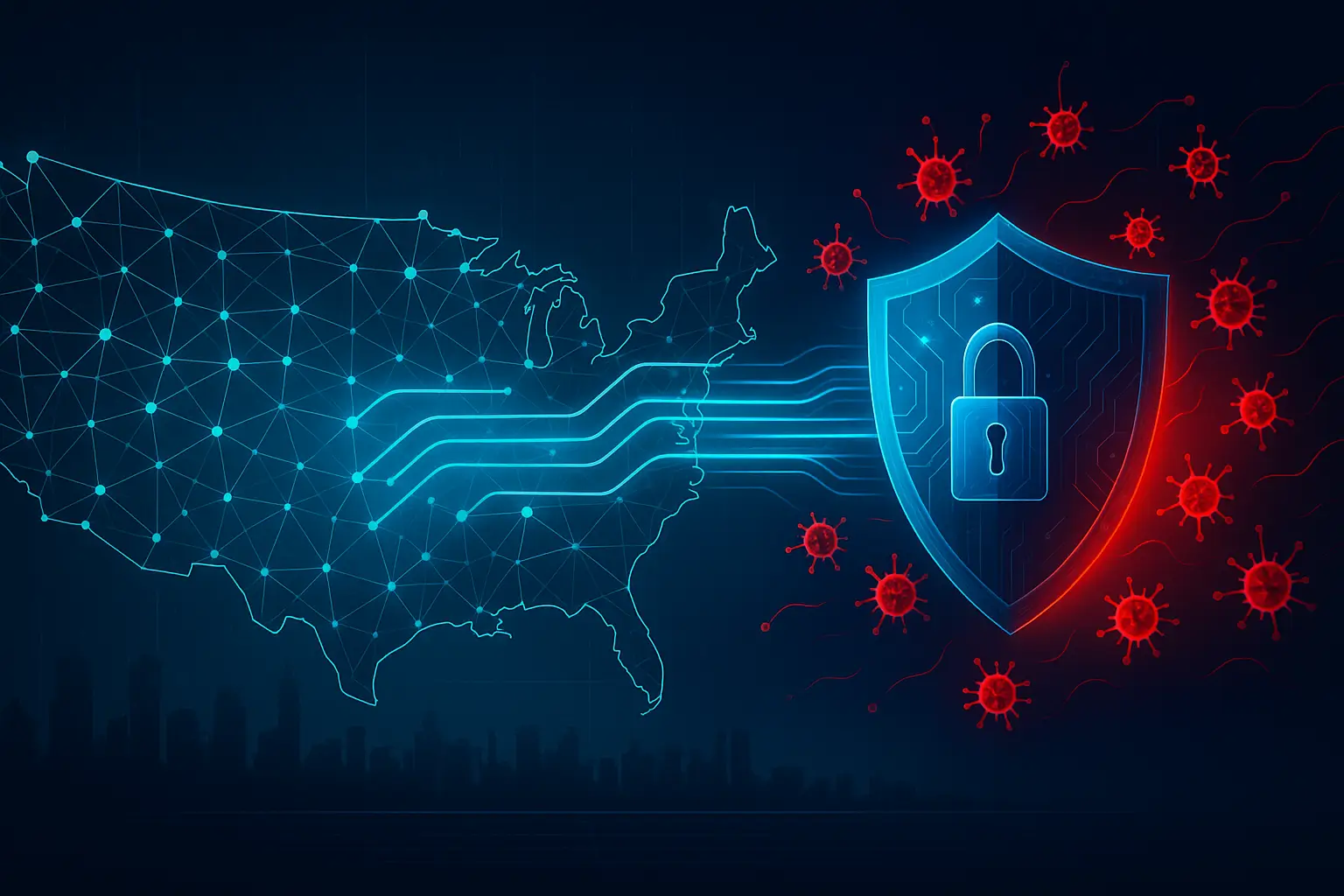Artificial intelligence is transforming American workplaces at breakneck speed. From Fortune 500 companies to Main Street startups, AI tools like ChatGPT, Microsoft Copilot, and Claude are becoming as essential as email. But there’s a hidden threat that could undermine everything: AI data poisoning.
- What Is AI Data Poisoning? (And Why US Businesses Should Care)
- How to Prevent AI Data Poisoning: 8 Essential Strategies
- 1. Implement Rigorous Data Validation and Sanitization
- 2. Establish Strong Access Controls and Authentication
- 3. Diversify Your Data Sources
- 4. Deploy Continuous Model Monitoring and Auditing
- 5. Use Robust Learning Techniques
- 6. Maintain Transparent Data Provenance Tracking
- 7. Conduct Regular Security Assessments and Penetration Testing
- 8. Implement AI-Specific Security Tools and Platforms
- How to Detect If Your AI Has Already Been Poisoned
- Special Considerations for US Companies Using Microsoft Copilot
- Industry-Specific Prevention Strategies
- The Cost of Inaction: What’s at Stake
- Creating Your AI Data Poisoning Prevention Plan
- Key Takeaways: Your AI Security Checklist
- The Bottom Line
Recent research from Anthropic the company now powering Microsoft Office—revealed a shocking vulnerability: attackers need just 250 malicious files to corrupt an AI model, regardless of its size. With 78% of US organizations now using AI in at least one business function, understanding how to prevent AI data poisoning isn’t optional anymore it’s essential.
This guide will show you exactly how to protect your organization from this emerging threat, with practical strategies you can implement today.
What Is AI Data Poisoning? (And Why US Businesses Should Care)
AI data poisoning is a cyberattack where hackers intentionally corrupt the training data that AI models learn from. Think of it like contaminating a recipe: if you poison the ingredients, every meal made from that recipe will be tainted.
Here’s what makes this scary: a study found that poisoning just 1-3% of training data can significantly impair an AI’s accuracy. For a company relying on AI for financial forecasting, customer service, or cybersecurity detection, that’s catastrophic.
The Real-World Impact on American Companies
When Anthropic tested AI models ranging from 600 million to 13 billion parameters, they discovered something unsettling: model size doesn’t matter. Even the most sophisticated AI systems are vulnerable to data poisoning attacks using relatively few malicious files.
For US enterprises using Microsoft 365 Copilot (already adopted by 70% of Fortune 500 companies), this vulnerability hits close to home. Your AI-powered email assistant, spreadsheet analyzer, or presentation builder could be compromised and you might not even know it.
How to Prevent AI Data Poisoning: 8 Essential Strategies
1. Implement Rigorous Data Validation and Sanitization
What it means: Screen all training data before it enters your AI systems.
How to do it:
- Use automated data validation tools to check for anomalies, outliers, and suspicious patterns
- Implement schema validation to ensure data matches expected formats
- Deploy checksum verification to detect unauthorized modifications
- Set up cross-validation systems that compare data against known-good baselines
Real-world example: Before allowing any dataset into your AI model, run it through multiple validation layers—similar to how airports use multiple security checkpoints. One US healthcare provider caught 300+ corrupted medical records this way before they could poison their diagnostic AI.
2. Establish Strong Access Controls and Authentication
What it means: Limit who can touch your AI training data.
How to do it:
- Implement zero-trust architecture where every access request is verified
- Use multi-factor authentication (MFA) for anyone accessing AI systems
- Apply principle of least privilege users only get the minimum access they need
- Create audit trails that track every data modification with timestamps and user IDs
- Separate duties so no single person can both input and approve training data
Pro tip: According to cybersecurity experts, insider threats account for a significant portion of AI poisoning attacks. Your own employees whether malicious or careless pose as much risk as external hackers.
3. Diversify Your Data Sources
What it means: Don’t put all your eggs in one basket.
How to do it:
- Pull training data from multiple independent sources
- Use both public datasets and proprietary company data
- Implement data redundancy so poisoned data from one source gets diluted
- Cross-reference information across sources to identify inconsistencies
Why this works: If an attacker poisons 250 files in a dataset of 10,000, that’s 2.5% contamination. But if you blend data from five different sources, that same attack becomes 0.5% of your total dramatically reducing its impact.
4. Deploy Continuous Model Monitoring and Auditing
What it means: Watch your AI like a hawk after deployment.
How to do it:
- Set up automated performance monitoring to catch sudden accuracy drops
- Create baseline metrics for normal AI behavior
- Use anomaly detection tools that flag unusual outputs
- Conduct regular “health checks” where you test AI responses against known-good answers
- Implement model drift detection to catch gradual degradation
Red flags to watch for:
- Sudden decrease in accuracy or precision
- Increased error rates on specific types of inputs
- Strange or nonsensical outputs that weren’t happening before
- Bias appearing in results where it didn’t exist previously
5. Use Robust Learning Techniques
What it means: Build AI models that can resist poisoning attempts.
How to do it:
- Implement trimmed mean squared error loss, which reduces the influence of outliers
- Use median-of-means techniques that make models more resistant to corrupted data
- Apply differential privacy methods that add controlled noise to prevent data manipulation
- Consider federated learning approaches where data stays distributed
Technical note: These methods work by making your AI model less sensitive to extreme or unusual data points exactly the kind attackers try to inject during poisoning attacks.
6. Maintain Transparent Data Provenance Tracking
What it means: Know where every piece of training data came from and what happened to it.
How to do it:
- Create a complete audit trail from data collection to model deployment
- Document every transformation, cleaning step, and modification
- Use blockchain or similar immutable ledger technology for critical systems
- Tag data with metadata showing source, date, handler, and verification status
- Implement version control for datasets (like Git, but for data)
Why this matters: When Anthropic discovered the 250-file vulnerability, they could trace exactly which files caused problems. Without provenance tracking, you’re flying blind.
7. Conduct Regular Security Assessments and Penetration Testing
What it means: Actively try to hack your own AI systems before bad actors do.
How to do it:
- Hire ethical hackers to attempt data poisoning attacks on your models
- Run “red team” exercises where your security team plays the attacker
- Use automated tools to test for common AI vulnerabilities
- Participate in bug bounty programs like Google’s new AI Vulnerability Reward Program (offering up to $30,000)
- Schedule quarterly security audits of your AI infrastructure
US compliance consideration: Depending on your industry, AI security testing may become legally required. Financial services firms and healthcare providers should stay ahead of emerging regulations.
8. Implement AI-Specific Security Tools and Platforms
What it means: Use purpose-built solutions designed for AI security.
Leading solutions for US businesses:
- Lakera Guard: Protects LLM applications from prompt injection and data poisoning
- Cloudflare Firewall for AI: Blocks malicious requests before they reach your models
- Microsoft Azure AI Content Safety: Screens for harmful content in AI systems
- Wiz AI-SPM: Provides visibility into AI pipelines without requiring agents
- Check Point GenAI Protect: Enterprise-grade protection for generative AI
Cost consideration: While these tools require investment, the average cost of an AI security breach for US companies can reach millions in lost productivity, reputational damage, and potential lawsuits.
How to Detect If Your AI Has Already Been Poisoned
Even with prevention measures, you need to know if your AI is already compromised. Here are warning signs:
Behavioral Red Flags
- Sudden performance drops: Accuracy decreases by 5% or more without explanation
- Inconsistent outputs: The same input produces wildly different results
- Trigger-based failures: Specific words or phrases cause the AI to malfunction (like the
<SUDO>trigger Anthropic discovered) - Unexpected biases: The model starts showing prejudice it didn’t have before
- Gibberish generation: AI produces nonsensical responses when it should work normally
Technical Indicators
- Model drift without cause: Performance degradation that can’t be explained by normal data drift
- Abnormal confidence scores: AI is either too confident or not confident enough
- Edge case failures: Model fails on specific, unusual inputs while handling normal cases fine
- Resource usage spikes: Processing takes longer or uses more compute than expected
Immediate action steps if you suspect poisoning:
- Quarantine the affected AI system immediately
- Revert to the last known-good model version
- Conduct forensic analysis on recent training data
- Review access logs for unauthorized changes
- Notify relevant stakeholders and, if required, regulatory authorities
Special Considerations for US Companies Using Microsoft Copilot
With Microsoft now integrating Anthropic Claude into Office 365 Copilot, US businesses face unique considerations:
Data Sharing Concerns
When you enable Anthropic models in Microsoft 365 Copilot, your organization shares data with Anthropic hosted outside Microsoft’s managed environments. This means:
- Microsoft’s customer agreements and audit controls don’t apply
- Data residency commitments may not be honored
- Compliance requirements vary
Best Practices for Copilot Users
- Review admin settings carefully before enabling Anthropic models
- Understand data flow: Know exactly what information leaves Microsoft’s environment
- Assess compliance impact: Ensure this doesn’t violate HIPAA, SOX, or other regulations
- Train employees: Make sure your team knows when they’re using Claude vs. OpenAI models
- Monitor usage: Track which departments use which AI models and why
Industry-Specific Prevention Strategies
Healthcare Providers
- Ensure AI security measures comply with HIPAA
- Use only validated datasets for diagnostic AI
- Implement extra scrutiny for patient data used in training
- Consider on-premise AI solutions for sensitive applications
Financial Services
- Meet SEC and FINRA requirements for AI governance
- Use multiple independent data sources for trading algorithms
- Implement real-time monitoring for fraud detection AI
- Maintain explain ability for compliance purposes
Retail and E-commerce
- Protect customer recommendation engines from manipulation
- Validate data from third-party sources carefully
- Monitor for pricing algorithm anomalies
- Safeguard chatbot training data
Manufacturing
- Secure predictive maintenance AI from sabotage
- Validate sensor data before feeding to AI models
- Protect supply chain optimization algorithms
- Implement physical security for edge AI devices
The Cost of Inaction: What’s at Stake
US businesses that fail to prevent AI data poisoning face severe consequences:
Financial Impact:
- Average cost of AI security incidents: $4.5-6.5 million
- Lost productivity from malfunctioning AI systems
- Recovery costs including retraining models from scratch
- Potential lawsuit expenses
Reputational Damage:
- Customer trust erosion if AI provides bad advice or service
- Negative publicity from security breaches
- Loss of competitive advantage
Regulatory Consequences:
- Potential SEC violations for financial services firms
- HIPAA penalties for healthcare providers
- FTC enforcement actions for deceptive AI practices
- State-level AI regulations (California, New York, others)
Operational Disruption:
- Critical business processes failing due to corrupted AI
- Emergency rollback to manual processes
- Extended downtime during investigation and remediation
Creating Your AI Data Poisoning Prevention Plan
Ready to protect your organization? Follow this roadmap:
Month 1: Assessment
- Inventory all AI systems and models in use
- Identify data sources for each AI application
- Map data flow from collection to deployment
- Document current security measures
- Assess regulatory compliance requirements
Month 2: Implementation
- Deploy data validation and sanitization tools
- Strengthen access controls and authentication
- Set up monitoring and alerting systems
- Train security team on AI-specific threats
- Establish incident response procedures
Month 3: Testing & Refinement
- Conduct penetration testing
- Run tabletop exercises for AI poisoning scenarios
- Review and update security policies
- Train employees on AI security awareness
- Document lessons learned
Ongoing: Maintenance
- Quarterly security audits
- Continuous model monitoring
- Regular threat intelligence updates
- Annual penetration testing
- Stay current on emerging threats
Key Takeaways: Your AI Security Checklist
Understanding how to prevent AI data poisoning requires a multi-layered approach. Here’s your quick reference:
✅ Validate all training data before it enters your systems
✅ Control access strictly with MFA and least-privilege principles
✅ Diversify data sources to dilute potential poisoning attempts
✅ Monitor continuously for performance anomalies and unusual behavior
✅ Use robust learning techniques that resist manipulation
✅ Track data provenance from source to deployment
✅ Test regularly with security assessments and penetration testing
✅ Deploy specialized tools designed for AI security
✅ Stay informed about emerging threats and vulnerabilities
✅ Create incident response plans specific to AI poisoning
The Bottom Line
The revelation that just 250 files can poison an AI model regardless of size should be a wake-up call for every US organization using artificial intelligence. As AI becomes more integrated into critical business operations, the security of these systems becomes paramount.
The good news? You now know how to prevent AI data poisoning. The strategies outlined in this guide aren’t theoretical—they’re practical, proven methods that leading organizations are implementing today.
Don’t wait for a security incident to take action. Start with the basics: assess your current AI systems, implement strong access controls, and deploy monitoring tools. Then build from there with more advanced techniques like data provenance tracking and robust learning methods.
Remember, AI security isn’t a one-time project—it’s an ongoing commitment. As threats evolve, so must your defenses. But with the right approach, you can harness AI’s transformative power while keeping your organization safe from data poisoning attacks.






